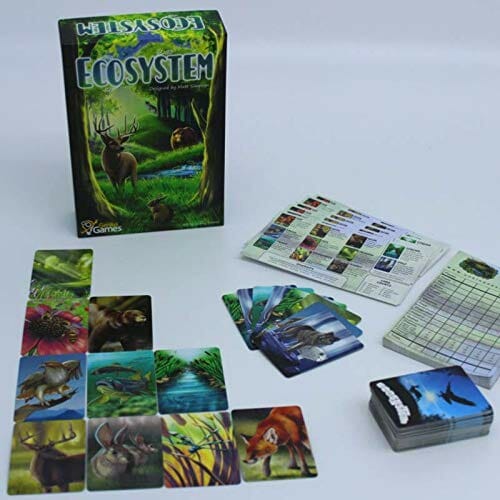Balance Your Own Ecosystem in the Great Board Game Ecosystem
Artwork and photo courtesy of Genius Games
Science games are trendy right now, with Wingspan, my #1 game of last year, building on real characteristics of over 100 species of North American birds to create a richly textured game that gets the science right. Genius Games is a small publisher that focuses specifically on games with science or math themes, including Periodic (played on the periodic table) and Cytosis (a game of cell division, endorsed by the Journal of Cell Science). One of their latest titles, Ecosystem, asks players to build tableaux of cards that score enough points to win yet are balanced like a real ecosystem so the player doesn’t lose points for a lack of biodiversity.
Ecosystem is a very straightforward game to play—all the complexity is in the scoring. The game itself is a card-drafting tableau builder, and if you know what those two terms mean, you have a pretty good idea of how the game works. You’ll build your ecosystem in a grid of four rows of five cards each, and you place those cards over two rounds, starting each round with ten cards. You’ll place a card, pass your remaining hand to the player to your left or right, place another card, and so on until all players have placed 10 cards in the round. The only restrictions on card placement are that you must place each card orthogonally adjacent to a card you’ve already placed, and you can’t go beyond the limits of four rows by five columns.
The deck includes 130 cards in total, so no matter your player count you won’t use all the cards in any game (the maximum is 120, or 20 cards each with six players). The most common cards are meadows and streams, of which there are 20 apiece, while the remainder of the deck includes eight to 12 each of nine different types of animals, birds, fish, or insects, each of which has a unique function in the game.
Two card types, streams and wolves, score competitively—the player with the most gets the most points, the player with the next-most gets a smaller point total, and so on. Most cards score based on what’s nearby, either immediately adjacent or within two cards, including trout, bear, dragonflies, and bees, as well as foxes, which score only if there are no bears or wolves adjacent to them. Meadows score in clusters—you have to have at least two meadow cards adjacent to each other to score at all.
One card, rabbits, scores just a single point each (up from nothing in the original edition), but when played gives you the only opportunity to move cards you’ve already played, either switching two in your tableau or replacing one with the rabbit and relocating the new one.
